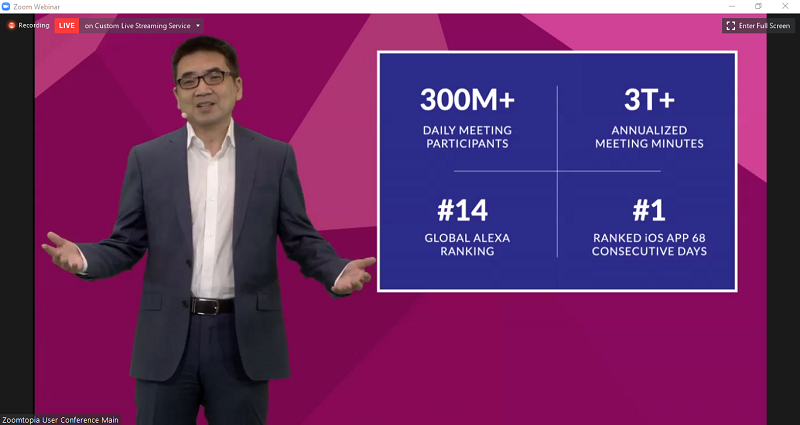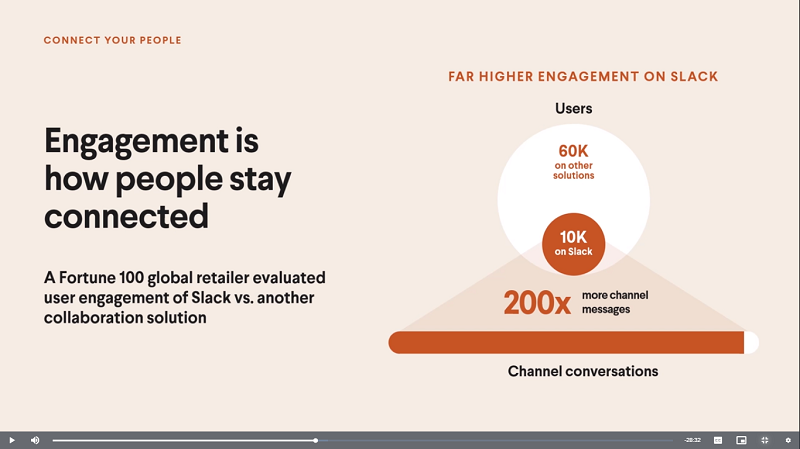Fall is always a busy time in our space for conferences. Last month, I attended nine virtual events, so there was a lot to take in. Things may seem less hectic with no travel, but with virtual events being relatively easy to stage, there are more of them, and I’ve never had to cover so much ground in such a short time. There were lots of great takeaways from these events that would require several articles to cover, but for this post, I’m going to reflect on connected threads from three of them.
Twilio, Slack, Zoom – the New Order?
During consecutive weeks, I attended events from arguably the most disruptive and innovative collaboration players and was struck by common themes among them. First was Twilio SIGNAL, followed by Slack Frontiers, and not to be outdone, Zoom’s Zoomtopia event. Not even five years ago, nobody in our space was talking much about these companies, and now, we can’t talk enough about them.
There’s definitely something happening here, and the deeper your roots in legacy, analog, and premises-based technologies are, the louder the call to get with the program. These companies are creating an entirely new world around how work gets done today, and you’d be hard pressed to find much room here for the collaboration players we know so well, or the legacy tools that are hard-wired for so many of us.
Making room for all of this will become moot when all the digital immigrants have retired and the PSTN goes dark, but for the time being, the old and new must coexist. That definitely presents challenges for the status quo, and given the momentum of these particular companies, anyone making buying decisions around collaboration technologies had better be paying attention. To that end, here are three common themes from these companies that I think really matter right now.
1. With Cloud, Trillion is the New Billion
We all know that cloud is the future, and it’s not hard to conclude that cloud-native companies like these three have some inherent advantages over the competition, most of whom have a lot or more than a little legacy DNA in their genes.
Cloud has many strengths, and let’s start with scale. Everyone tries to leverage this attribute, but these companies are hyper-scaling to heights we’ve never seen in the UCC space. According to CEO Eric Yuan, Zoom is on track to hit three trillion meeting minutes this year, and Twilio’s CEO Jeff Lawson states that every year they are powering one trillion human interactions. I don’t think Slack has joined the trillionaire club yet, but they’re certainly built for it.
I don’t care what industry you’re in, a trillion of anything is a BIG number, and I haven’t seen any metrics in our space that come close to this — and these companies are talking like it’s no big deal. I think it’s a big deal, and a sign of how cloud is going to shape the winners and losers.
Other sectors like mobility are hitting those numbers, sure, but our space doesn’t natively have metrics that really scale that high. Doing scale well alone is no guarantee of success, but it’s a necessary condition. And at present, these events are showing us how quickly the volumes are growing, so get used to hearing about trillions.
Speed and agility are other important attributes that cloud enables, and these have been particularly important in pandemic times. The disruption across all sectors is unprecedented, and businesses had to adapt to situations that they weren't prepared for. Again, the winners will be defined by those who are agile enough to respond quickly — at scale — and with solutions that can hit the ground running.
Twilio cited an example where developers were able to build a contact center from scratch in a week for a customer that needed to quickly support their customers during COVID-19. Slack shared a great case study where TD Ameritrade was able to scale their workforce of 10,000 to being fully WFH in only 10 days when COVID-19 hit. These kinds of rapid shifts would be unthinkable with premises-based technology, and the pandemic has been a real test for collaboration providers to step up when customers need them the most.
2. It’s About the Platform, not the Applications
A consistent theme across these three events was a firehose of updates that becomes overwhelming after about five minutes. With Zoom, we heard about meeting recording highlights, waiting rooms, noise suppression, digital whiteboard, end-to-end encryption, etc. Twilio talked about over 180,000 “production deployments” this year. I have no idea what that actually means, and while it’s way less than a trillion, it means a lot of incremental improvements to make the platform richer and constant innovation. How many new PBX features were added in the last 40 years? You can probably count them on one hand.
Slack had lots of interesting updates as well, such as “instant audio,” where users can go voice-only inside a channel on the fly. UC vendors would call this click-to-call or PBX integration, but in Slack’s world, it’s just audio – and has nothing to do with telephony or making a call. No external device is needed for voice here — exact same functionality for end users as with UC, but this is how it goes in the cloud world and personifies their mantra to a tee — “Slack is where work happens.”
Along those lines, cloud is where platforms happen. This is a very different model for building technology, and these companies are at the vanguard for innovation in the collaboration space. To properly understand the implications, you may need to think differently about these companies.
Zoom is not a video company. Twilio is not a messaging company. Slack is not a team messaging company. Maybe a year ago, but not today. They are all platform companies, and all the new features we heard about are not just standalone add-ons; they are additive for making the platform richer and stickier. Don’t get me wrong — each new feature is cool and warrants discussion (such as
here,
here, or
here on No Jitter) — but I think the bigger story is their potential to reshape the collaboration space as platform plays.
3. It’s About Changing Behaviors and Doing Things Differently
Old habits may die hard, but they do die. And sometimes, habits change easily and quickly. These three companies aren’t the only ones re-inventing how we work, but they sure are having a lot of success getting both organizations and workers to do things differently by adopting their technologies.
There is no shortage of digital immigrants who can be highly productive using email and desk phones, and there’s a reason why the installed base of legacy PBXs remains large. Of course, the exact opposite is true for digital natives, and we know how the demographics are rapidly trending. These companies clearly understand that, and their fantastic growth – COVID-19 notwithstanding – validates that plenty of people are ready, willing, and able to try new tools and leave older ones behind.
Zoom is a latecomer to video, but in a New York minute, they’ve become a verb that applies to just about anyone using video. As Yuan likes to say, “Eat, sleep, Zoom. Zoom is what you do.” Steve Jobs would be proud. We all know how ubiquitous Zoom has become with video, but they’re trying to do the same with telephony, and once that domino falls, they can become a full-on UC provider.
As an aside, I found it interesting that Zoom Phone was built in-house, and not via an acquisition — which they could have easily done. They feel this approach is a differentiator, and time will tell if their recipe for success with video can be replicated here.
Zoom Phone got a lot of attention during Zoomtopia, and during a session with some large customers — eBay, ServiceNow, ViacomCBS — we learned how old habits can indeed die. Prior to going with Zoom, internal surveys showed that employees still wanted to keep their desk phones. Once they started using Zoom Phone, 90% changed their minds and have made the shift away from desk phones.
Another example of old habits dying hard came from a Finserv user panel led by Zoom CIO Harry Moseley. The focus was about using Zoom overall — not just Phone — to help enterprises transition their workers to WFH. These were some pretty major players — Capital One, Moody’s, Ally — and if Zoom is good enough for them, that’s another validation point for their model, especially for such a conservative vertical.
The theme was just as strong with Slack, where Stewart Butterfield’s view is “the old ways of working aren’t coming back.” Synchronous workstyles, where everyone is in the same place at the same time, are no longer viable, especially with so much remote working. People will burn out staying in video meetings all day, and tools like Slack enable asynchronous working, where they can be more productive in a distributed environment.
CPO Tamar Yehoshua made a compelling case for why “email is no longer the right tool” for today’s workplace, and for how channel-based messaging is a better model, reporting that 31% of workers feel more productive, 45% less use of email, and 21% fewer meetings. Not only does Slack drive better productivity in today’s workplace, but channels drive worker engagement, where it’s easier to build culture and stay connected while working in isolation.
Another important aspect of engagement is making productive use of all the information we have to manage daily. Coming back to the TD Ameritrade customer cited earlier, they found that email was only getting 50% readership, but with Slack, messages were getting 99% readership. That’s double the level of engagement, with very little information going into a black hole, which seems to be the fate of most emails.
Other Slack showcase enterprise customers like HSBC amplified the notion that this new way of working is driving better engagement, higher productivity, and improved organizational agility. For the UC community, I would note that Slack’s focus on workflows may be providing richer business value than the communications capabilities that UC offerings have traditionally been built around. Slack isn’t able to reshape enterprise collaboration in its own image yet, but there’s a lot of validity to their model at this point in time. Just to be clear — Slack isn’t a UC-killer — it’s not built as a replacement, but for certain workflows, it’s a better tool.
Let’s not forget Twilio, which is all about developers and the API economy. It’s easy to think about messaging and SMS with them, but Lawson paints a much bigger picture – “last year, we touched 3 billion unique phone numbers, sent messages to over half the world’s email addresses, and delivered 2.9 billion minutes of video – all on a platform used by over 200,000 businesses.”
There’s a lot of “doing things differently” opportunity when using a multichannel platform like this, and for companies receptive for change, the sky is the limit. Not surprisingly, much of their success has been with “digital disruptors” like Lyft, Stripe, and Airbnb, companies that are built on cloud, just like Twilio. Where things get interesting is when more conventional enterprises see the fit here, especially in changing times.
A great example was with Nike, where CEO John Donahue talked about the challenges they faced with COVID-19 shutting down retail, which is their direct channel for customer engagement. Using Twilio Flex, they were able to create new forms of digital customer engagement, where both store employees — “digital athletes” — and customers could interact online, not limited to the physical location of a store. In terms of changing behaviors, this digital way of doing business continues growing even after stores re-opened.
Clearly, many customers are ready for this, and doing things differently has come pretty easily once the right capabilities are in place. Twilio seems to be on the right track here, and there’s no reason their platform can’t deliver great results for any business or vertical that needs a re-think, not just for pandemic times, but for digital times.
To close out on a timely note — speaking of change and doing things differently — Lawson spoke with former President Obama during SIGNAL, pictured below. It was a real highlight of the event, and I’ll bet that magnetic smile of his is a whole lot bigger now.
And I’ll bet you thought this post was about technology.
This post is written on behalf of BCStrategies, an industry resource for enterprises, vendors, system integrators, and anyone interested in the growing business communications arena. A supplier of objective information on business communications, BCStrategies is supported by an alliance of leading communication industry advisors, analysts, and consultants who have worked in the various segments of the dynamic business communications market.














